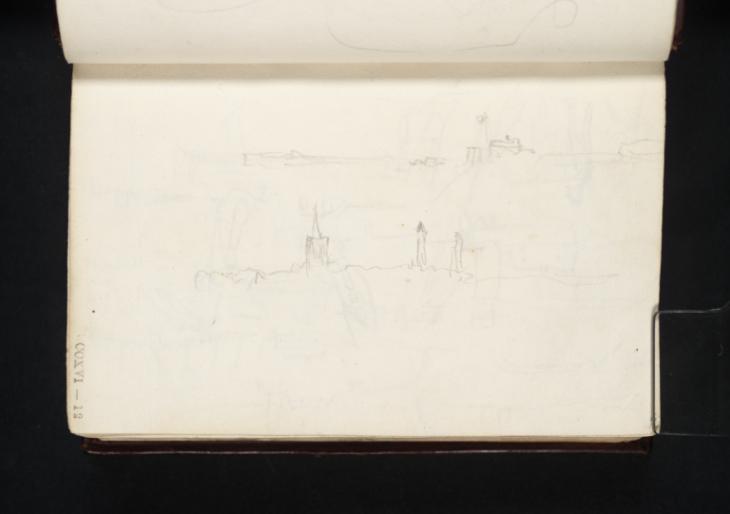Joseph Mallord William Turner Calais Harbour from a Distance 1824
Image 1 of 2
Joseph Mallord William Turner,
Calais Harbour from a Distance
1824
Joseph Mallord William Turner 1775–1851
Folio 12 Recto:
Calais Harbour from a Distance 1824
D19574
Turner Bequest CCXVI 12
Turner Bequest CCXVI 12
Pencil on white wove paper, 78 x 118 mm
Inscribed in blue ink by Ruskin ‘12’ top right
Stamped in black ‘CCXVI–12’ bottom right
Inscribed in blue ink by Ruskin ‘12’ top right
Stamped in black ‘CCXVI–12’ bottom right
Accepted by the nation as part of the Turner Bequest 1856
References
1909
A.J. Finberg, A Complete Inventory of the Drawings of the Turner Bequest, London 1909, vol.II, p.669, as ‘Distant church, &c.’.
These previously unidentified sketches show the coast and harbour at Calais.1 The spired church and two towered buildings correspond exactly to three earlier sketches of the French port in the Remarks (Italy) sketchbook of 1820 (Tate D16886; Turner Bequest CXCII 104). This sketch and and those produced four years earlier clearly shows the silhouettes of the Eglise de Notre-Dame (see Tate D19577; Turner Bequest CCXVI 13a), the Tour de Guet, and the Hôtel de Ville.
The towers of both the town hall and Tour de Guet rose ‘to a considerable height’ over the town, according to one commentator. Where the Hôtel de Ville marked the civic and administrative centre of Calais, the Tour de Guet played a crucial role in maritime safety and defence as the town’s principal lighthouse and watchtower. By the time of Turner’s visit in 1824, Guet Tower boasted a most ‘useful and ornamental revolving light’ composed of ‘six parabolical reflectors’ which emitted beams of light as an aid to mariners navigating the Channel (see Tate impression T04761 for an engraving after Turner’s illustration of the tower in Scott’s Poetical Works, c.1834–6).2
The squat building seen in the uppermost sketch is the Fort Rouge (see Tate D04199, D24879; Turner Bequest LXXI 7, CCLX 43). Designed by Jean Caligny in 1691 and completed in 1695, the Fort Rouge was a battery consisting of a solid wooden platform supported by wooden stilts.3 It was built out to sea, where the water was shallow enough to prohibit attacking ships from advancing.4 The fort played a significant role in the Napoleonic Wars, sheltering French ships coming in and out of Calais harbour.5 Clarkson Stanfield also pictured Fort Rouge for a series of engravings entitled Stanfield’s Coast Scenery of 1836 (see Tate impressions T05685 and T05686).
For other sketches of Calais in this book see Tate D19923–D19927; Turner Bequest CCXVI 186a–188a.
Alice Rylance-Watson
February 2014
How to cite
Alice Rylance-Watson, ‘Calais Harbour from a Distance 1824 by Joseph Mallord William Turner’, catalogue entry, February 2014, in David Blayney Brown (ed.), J.M.W. Turner: Sketchbooks, Drawings and Watercolours, Tate Research Publication, April 2015, https://www


